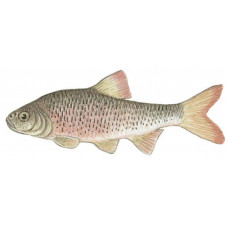Latin name
Luxilus chrysocephalus
Other names
Shiner
Identification
The striped shiner is a silvery, laterally compressed minnow with large eyes and a terminal mouth. The open part of the scales near the anterior lateral line is much deeper than wide. The anterior part of the scales is darkly pigmented, giving the sides a sickle shape. Several parallel stripes run along each side of the upper body, converging on the posterior part of the dorsal fin. In L. c. chrysocephalus the stripes are wavy, while in L. c. isolepis they are straight. Other characteristics include 8-10 anal fin rays and a complete lateral line with 36-42 scales. In the mating male, the head, body, and edges of all fins are pink-pink, and there are tubercles on the head, snout, lower jaw, and pectoral fins.
Distribution
The subspecies L. c. chrysocephalus is common in the lower Mississippi River drainages and along the Gulf Coast. L. c. isolepis occurs in the Great Lakes drainages and Mississippi River basins north of the Red River in Arkansas.
Habitat
Striped shiners are found in waters ranging from small streams to small rivers, but are most abundant in small and medium-sized streams. Their preferred habitats are ponds, channels, and backwaters of flowing streams. They are more commonly found in free-flowing streams with clear or slightly turbid water.
Size
Adults can exceed 8 inches in length, but most are less than 5 inches. Can live up to 6 years.
Life history and Behavior
Striped shiners reach sexual maturity in their second year of life. Adult males are larger than females. Spawning occurs from late spring to early summer in water temperatures between 61° and 81°F. Striped shiners are pit spawners. Males dig small pits on top of chub nests or directly on the stream bottom and aggressively defend these pits to attract females to spawn. Because of their tendency to spawn over chub nests, they often hybridize with chub and other minnows.
Food and feeding habits
Striped shiners feed primarily on insects, but can also eat detritus, algae, fish eggs, crustaceans and small fish.
Reproduction
No information
| Classification | |
| Phylum | Chordata |
| Class | Actinopterygii |
| Squad | Cypriniformes |
| Family | Cyprinidae |
| Genus | Luxilus |
| Species | L. chrysocephalus |
| Features | |
| Conservation status | Least Concern |
| Habitat | Pelagic |
| Life span, years | 6 |
| Maximum body weight, kg | No information |
| Maximum length, cm | 20.32 |
| Sailing speed, m/s | No information |
| Threat to people | Edible |
| Way of eating | Predator |

